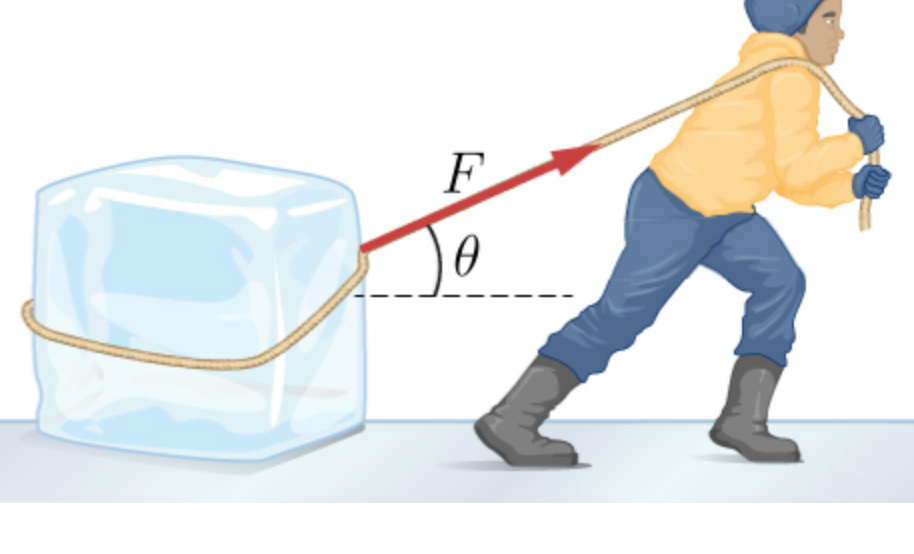A contestant in a winter sporting event pulls an m kg block of ice across a frozen lake by applying a force F at an angle θ above the horizontal as shown. Assume that the coefficient of static friction for ice on ice is 0.0300, and the coefficient of kinetic friction for the same is 0.0100. Let to the right be the positive x direction and up be the positive y direction for your equations. Please use the interactive area below to draw a free body diagram to represent the situation where the contestant is pulling, but the block has not yet started to move. Use Fs for the force of static friction and Fk for the force of kinetic friction if they are needed for your free body diagram. 17% Part (b) Select the correct expression for the net force in the horizontal direction, ΣFx. 17% Part (c) Select the correct expression for the net force in the vertical direction, ΣFy. 17% Part (d) Obtain a numeric value, in newtons, for the magnitude of the maximum applied force, F, consistent with static friction when the force makes an angle 16° above the horizontal and the mass of the block is 38 kg. 17% Part (e) Please use the interactive area below to draw a free body diagram to represent the situation where the contestant is pulling, and the block has just begun to accelerate. Use Fs for the force of static friction and Fk for the force of kinetic friction if they are needed for your free body diagram. 17% Part (f) Obtain a numeric value for the acceleration, a, in meters per squared seconds, when the mass of the block is 38 kg and the angle of the rope is 16° above the horizontal. For the magnitude of the applied force, use the threshold value obtained in part (f).
A contestant in a winter sporting event pulls an m kg block of ice across a frozen lake by applying a force F at an angle θ above the horizontal as shown. Assume that the coefficient of static friction for ice on ice is 0.0300, and the coefficient of kinetic friction for the same is 0.0100. Let to the right be the positive x direction and up be the positive y direction for your equations. Please use the interactive area below to draw a free body diagram to represent the situation where the contestant is pulling, but the block has not yet started to move. Use Fs for the
17% Part (c) Select the correct expression for the net force in the vertical direction, ΣFy.
17% Part (d) Obtain a numeric value, in newtons, for the magnitude of the maximum applied force, F, consistent with static friction when the force makes an angle 16° above the horizontal and the mass of the block is 38 kg.
17% Part (e) Please use the interactive area below to draw a free body diagram to represent the situation where the contestant is pulling, and the block has just begun to accelerate. Use Fs for the force of static friction and Fk for the force of kinetic friction if they are needed for your free body diagram.
17% Part (f) Obtain a numeric value for the acceleration, a, in meters per squared seconds, when the mass of the block is 38 kg and the angle of the rope is 16° above the horizontal. For the magnitude of the applied force, use the threshold value obtained in part (f).

Trending now
This is a popular solution!
Step by step
Solved in 6 steps with 2 images









